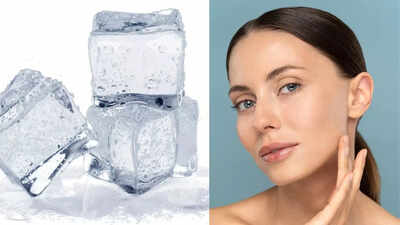Facial icing, also known as skin icing or cryotherapy, has surged in popularity across social media, touted for its potential therapeutic and aesthetic benefits. Proponents claim it can alleviate acne, reduce swollen eyes, and address various other skin concerns. However, while cold therapy holds a place in treating injuries and mitigating pain, the scientific foundation for its purported benefits on facial skin remains limited.

Despite the absence of conclusive scientific evidence, many individuals believe in the efficacy of facial icing. This widespread belief has fueled its emergence as a prominent beauty trend. Nevertheless, further research is imperative to substantiate its true effects on the skin.
According to health experts, two primary methods are favored by those who advocate for ice facials:
Regardless of the chosen method, gently massage your face with slow, circular motions for approximately 1 to 2 minutes. Exercise caution to prevent prolonged direct contact between the ice and your skin, as extended exposure can induce irritation.
This circular massage can be incorporated into your routine once daily, focusing on areas such as:
Prior to experimenting with ice facials, it is advisable to seek personalized guidance from a healthcare or skincare professional. Consider the following tips:
It is essential to change the ice and wrapping frequently to prevent the spread of bacteria. Facial icing should serve as a complement to, rather than a substitute for, your established skincare regimen.
Several factors contribute to the growing popularity of ice facials:
Health professionals caution that prolonged or improper facial icing can lead to:
Furthermore, individuals with specific health conditions, such as diabetes or Raynaud's syndrome, should exercise caution or consult a physician before engaging in facial icing, as it may exacerbate existing sensitivities or nerve-related issues.
Facial icing offers several potential benefits, including:
While these benefits appear promising, it is imperative to acknowledge that further research is warranted to corroborate the direct effects of facial icing on puffiness and acne.
Newer articles
 Daren Sammy Fined, Handed Demerit Point for Umpire Criticism After Test Match Comments
Daren Sammy Fined, Handed Demerit Point for Umpire Criticism After Test Match Comments
 Gavaskar Calls for Yadav's Inclusion, Questions Middle Order After India's Test Defeat
Gavaskar Calls for Yadav's Inclusion, Questions Middle Order After India's Test Defeat
 Decoding Your Health: Spotting 5 Prediabetes Warning Signs Before a Blood Test
Decoding Your Health: Spotting 5 Prediabetes Warning Signs Before a Blood Test
 X Corp. Cracks Down: Half a Million Indian Accounts Suspended for Policy Breaches
X Corp. Cracks Down: Half a Million Indian Accounts Suspended for Policy Breaches
 Headline:
Early Warning Signs: 5 Heart Attack Symptoms to Watch Out For Weeks in Advance
Headline:
Early Warning Signs: 5 Heart Attack Symptoms to Watch Out For Weeks in Advance
 Facial Icing: Benefits, Risks, and Safe Application of This Viral Beauty Trend
Facial Icing: Benefits, Risks, and Safe Application of This Viral Beauty Trend
 Chess Sensation Praggnanandhaa Joins Magnus Carlsen's Team Liquid for Esports World Cup
Chess Sensation Praggnanandhaa Joins Magnus Carlsen's Team Liquid for Esports World Cup
 Mastering JPG to PDF Conversion: A Graphic Designer's Guide to Quality and Efficiency
Mastering JPG to PDF Conversion: A Graphic Designer's Guide to Quality and Efficiency
 MI New York's Tajinder Dhillon Shines: From IPL Benchwarmer to MLC Star
MI New York's Tajinder Dhillon Shines: From IPL Benchwarmer to MLC Star
 Akmal Blasts PCB's Interim Coach Choice: Ex-Cricketer Questions Logic Behind Mahmood Appointment
Akmal Blasts PCB's Interim Coach Choice: Ex-Cricketer Questions Logic Behind Mahmood Appointment